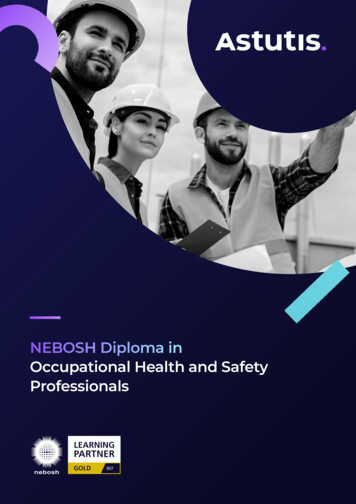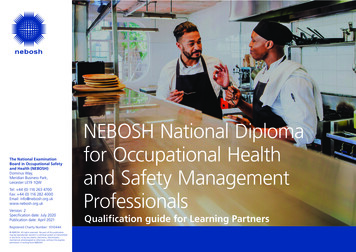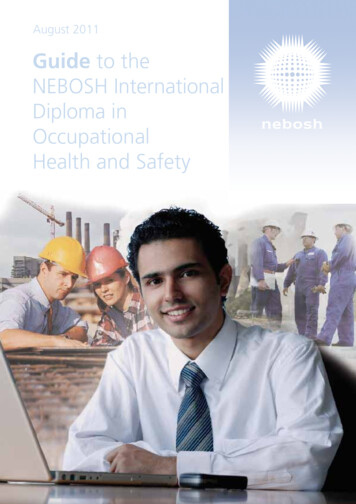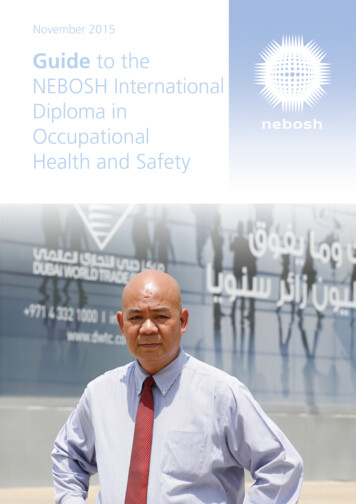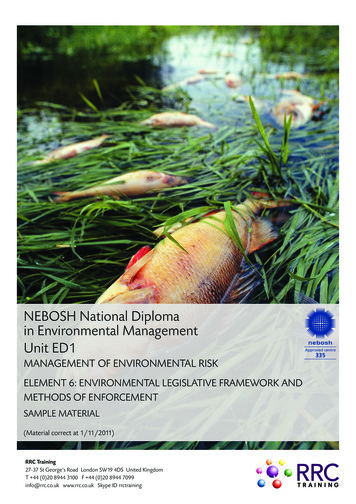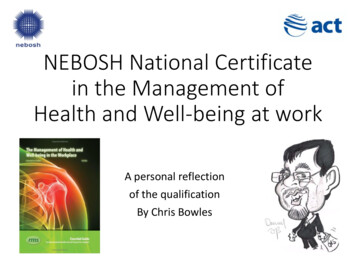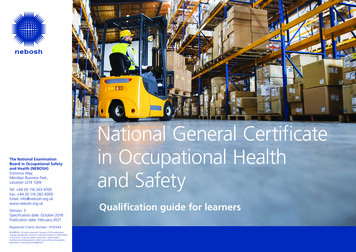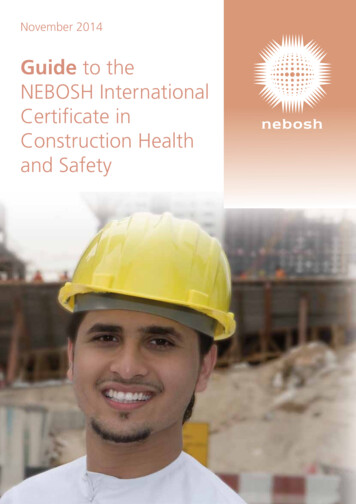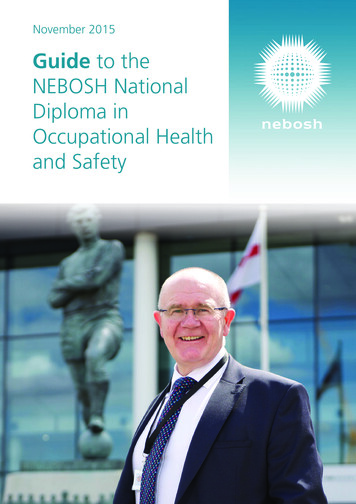
Transcription
November 2015Guide to theNEBOSH NationalDiploma inOccupational Healthand Safety
Front cover photograph:Graham LoshFA Group Occupational Health and Safety ManagerAwarded the: NEBOSH National General Certificate in Occupational Healthand Safety in 2005 NEBOSH National Certificate in Fire Safety and RiskManagement in 2008 NEBOSH National Diploma in Occupational Health and Safetyin 2010Qualification title: National Diploma in Occupational Health and SafetyVersion: 1Specification date: November 2015Guide publication date: December 2015The National Examination Board in Occupational Safety and Health (NEBOSH),Dominus Way, Meridian Business Park, Leicester LE19 1QW.Registered Charity Number: 1010444Telephone:Fax:Email:Website: 44 (0) 116 263 4700 44 (0) 116 282 4000info@nebosh.org.ukwww.nebosh.org.uk NEBOSHAll rights reserved. No part of this publication may be reproduced, stored in a retrieval system ortransmitted in any form, or by any means, electronic, electrostatic, mechanical, photocopied orotherwise, without the express permission in writing from NEBOSH. NEBOSH 2016
Guide to the NEBOSH National Diploma in OccupationalHealth and Safety (November 2015 .192.1222233344446666777Qualification structure2.12.22.32.42.52.62.72.83.Benefits for employersDesignatory lettersProfessional membershipQualification level and UK accreditationKey topics coveredCourse tuition and private study time requirementsEntry requirementsMinimum standard of English required for studentsLegislationLegislative updatesNational Occupational Standards (NOS) and best practiceQualification typeQualification progressionProgrammes offered by NEBOSH-accredited course providersExamination datesSpecification dateSyllabus development and reviewFurther information for studentsFurther information for accredited course providersStudent enrolmentUnit assessmentsAssessment setting and markingUnit pass standardsUnit certificatesQualification gradeQualification parchmentRe-sitting unit/s88101010101010Policies3.13.23.33.4Requests for access arrangements/reasonable adjustmentsRequests for special considerationEnquiries about results and appealsMalpractice NEBOSH 201612121213
4.Notes for tutors4.14.24.34.44.54.6Case studies / past incidentsDecided casesTutor referencesTeaching of unitsConflict of interestMinimum standard of English required for tutors5. Syllabus - NEBOSH National Diploma in Occupational Health and Safety(November 2015 specification)5.114141414141516Unit A: Managing health and safetyElement A1: Principles of health and safety managementElement A2: Principles of health and safety lawElement A3: Criminal lawElement A4: Civil lawElement A5: Loss causation and incident investigationElement A6: Measuring and reviewing health and safety performanceElement A7: The assessment and evaluation of riskElement A8: Risk controlElement A9: Organisational factorsElement A10: Human factorsElement A11: The role of the health and safety practitionerUnit A: Tutor ReferencesHealth and safety incidentsStatutory instrumentsOther relevant references2022252730323436384143454545465.2 Unit B: Hazardous substances / agentsElement B1: Managing occupational healthElement B2: Identification, assessment and evaluation of hazardous substancesElement B3: The control of hazardous substancesElement B4: The monitoring and measuring of hazardous substancesElement B5: Biological agentsElement B6: Noise and vibrationElement B7: RadiationElement B8: Mental ill-health and dealing with violence and aggression at workElement B9: Musculoskeletal risks and controlsElement B10: Work environment risks and controlsUnit B: Tutor ReferencesStatutory instrumentsOther relevant references NEBOSH 201648505255575963666971737374
5.3 Unit C: Workplace and work equipment safetyElement C1: Workplace welfare requirements and specific workplace issuesElement C2: Fire and explosionElement C3: Workplace fire risk assessmentElement C4: The storage, handling and processing of dangerous substancesElement C5: Work equipmentElement C6: Workplace machineryElement C7: Mobile, lifting, access and work at height equipmentElement C8: Electrical safetyElement C9: Construction and works of a temporary nature - hazards and controlsElement C10: Workplace transport and managing work-related road riskUnit C: Tutor ReferencesHealth and safety incidentsStatutory instrumentsOther relevant references5.4 Unit DNI: Application of health and safety management in the workplace5.7779818385889092949698989899103Sample question papers5.15.25.3Unit A: Managing health and safetyUnit B: Hazardous agents in the workplaceUnit C: Workplace and work equipment safety NEBOSH 2016105110114
The Guide to the NEBOSH National Diploma in Occupational Health and Safety(November 2015 specification)1.IntroductionThe NEBOSH National Diploma is the flagship NEBOSH qualification and is the first UKvocational qualification to be developed specifically for health and safety professionals. TheNational Diploma has become established as the most popular professional qualification forsafety and health practitioners in the UK, with over 11000 students having achieved thequalification since its introduction in 1988.The NEBOSH National Diploma is the qualification for aspiring health and safetyprofessionals, building directly upon the foundation of knowledge provided by the NEBOSHNational General Certificate. It is designed to provide students with the knowledge andunderstanding required for undertaking a career as a health and safety practitioner and italso provides a sound basis for progression to postgraduate study.1.1Benefits for employersAccidents and work-related ill-health affect all types of workplaces and occupations. In theyear 2014/15 the following UK statistics were reported by the Health and Safety Executive: 142 people killed at work;1.2million people suffered from work-related illness;2358 Mesothelioma deaths due to past exposures (2013 figures);13000 deaths occur each year from work-related lung disease and cancer due to pastexposure (primarily from dust and chemicals at work);76000 other injuries reported under the Reporting of Injuries, Diseases and DangerousOccurrences Regulations 2013;611000 other injuries occurred at work (Labour Force Survey);27.3million days lost due to work-related illness and workforce injury;Mental ill-health gave rise to most working days lost (an estimated 234000 cases); 14.3billion is the estimated cost of injuries ( 4.96billion) and ill health ( 9.46billion) fromworking conditions (2013/14 figures).In addition to the direct costs of sick pay and absence, employers can find themselvesdealing with criminal prosecution, claims for compensation, adverse publicity and harm toboth business reputation and profitability. The following enforcement actions were taken inGreat Britain during 2014/15: 586 cases were prosecuted by the HSE in England and Wales;70 cases were prosecuted by Local Authorities in England and Wales;72 cases were prosecuted by the Procurator Fiscal in Scotland;12430 enforcement notices were issued by all enforcing authorities.In addition to prosecutions and enforcement notices the HSE is also able to charge Fees forIntervention (FFI) for those organisations that are found to have made a ‘material breach’.The FFI is currently 124 per hour.The management of health and safety in the workplace is not only a legal obligation and amoral imperative, it also makes good business sense. Qualified health and safetyprofessionals are an asset to their organisation. They can help to reduce costs bypreventing accidents and ill health of employees, while at the same time avoidingunnecessary expense by over-reacting to trivial risks. This in turn can lead to improvedproductivity and the raising of workforce morale. Effective health and safety managementshould be recognised as an essential element of a successful management strategy. NEBOSH 20161
The Guide to the NEBOSH National Diploma in Occupational Health and Safety(November 2015 specification)Courses leading to the NEBOSH National Diploma may be taken in a variety of formats andat a pace to fit around the needs of the individual and the business. Its unitised structurerecognises success as the student progresses. Its practical approach promotes theapplication of the knowledge acquired on the course to problem solving in the student’s ownworkplace.1.2Designatory lettersHolders of the NEBOSH National Diploma in Occupational Health and Safety may use thedesignatory letters ‘DipNEBOSH’ after their name.1.3Professional membershipThe qualification meets the academic requirements for application for Graduate Membership(Grad IOSH) of the Institution of Occupational Safety and Health (IOSH – www.iosh.co.uk).This is the first step to becoming a Chartered Health and Safety Practitioner as a CharteredMember of IOSH (CMIOSH).Holders of the National Diploma are able to waive the Board of Certified SafetyProfessionals’ Associate Safety Professional (ASP) examination so that, if they meet allother requirements, they may sit directly for the Certified Safety Professional (CSP)examination.Holders of the NEBOSH National Diploma in Occupational Health and Safety and either theNEBOSH National or International Certificate in Construction Health and Safety meet theheadline entrance criteria requirements for Registered Construction Safety Practitioner(RMaPS) and membership of the Association for Project Safety (APS).The National Diploma is also accepted by the International Institute of Risk and SafetyManagement (IIRSM) as meeting the academic requirements for full membership (MIIRSM).1.4Qualification level and UK accreditationNEBOSH is intending to apply for the NEBOSH National Diploma in Occupational Healthand Safety (November 2015 specification) to be accredited and credit rated by the ScottishQualifications Authority (SQA - www.sqa.org.uk) for delivery across the UK. The February2010 specification is rated within the Scottish Credit and Qualifications Framework (SCQF www.scqf.org.uk) at SCQF Level 10 with 48 SCQF credit points. It is anticipated that therevised November 2015 specification will be at the same level with 51 credits.For users in England, Wales and Northern Ireland, this is comparable to a VocationallyRelated Qualification (VRQ) at Level 6 within the Regulated Qualifications Framework (RQF)and Qualifications and Credit Framework (QCF), or Honours Degree standard.For further information please refer to the “Qualifications can cross boundaries” comparisonchart issued by the UK regulators, available from the SQA website (www.sqa.org.uk).1.5Key topics covered Managing health and safety Hazardous agents in the workplace NEBOSH 20162
The Guide to the NEBOSH National Diploma in Occupational Health and Safety(November 2015 specification) Workplace and work equipment safety Practical application of health and safety theory1.6Course tuition and private study time requirementsUnit A: 103 hours tuition and 85 hours private studyUnit B: 65 hours tuition and 50 hours private studyUnit C: 70 hours tuition and 50 hours private studyUnit DNI: 5 hours tuition and 72 hours private studyTotal: 188 hoursTotal: 115 hoursTotal: 120 hoursTotal: 77 hoursA programme of study therefore needs to be based around a minimum of 243 taught hoursand approximately 257 hours of private study for an overall total of 500 Hours.A full-time block release course would be expected to last for a minimum of 7-weeks (35working days) and a part-time day release course would be spread over at least 30-weeks.The tuition hours should be added to the recommended private study hours to give theminimum number of hours for students studying by open or distance learning.Tuition time should normally be allocated proportionate to the tuition time for each elementbut may require adjustment to reflect the needs of a particular student group.Quoted hours do not include assessment time, ie, sitting written examinations.1.7Entry requirementsThe NEBOSH National Diploma syllabus assumes that students will have knowledge ofhealth and safety equivalent to that provided by the NEBOSH National General Certificate(NGC).The achievement of the NGC or direct equivalent prior to undertaking the Diplomacourse is highly recommended, because of the demands of high level study, the timecommitment required and the complementary nature of the NEBOSH NGC andNational Diploma. Further information on the NEBOSH National General Certificate can befound via our website www.nebosh.org.uk.It should be noted that currently the assessments are offered (and must be answered) inEnglish only. The qualification includes a requirement to write an extended assignmentbased on the student’s own workplace, which must also be in English. Students shoulddiscuss this requirement with the accredited course provider before undertaking thequalification.Students must satisfy any entry requirements specified by the course provider. Acceptanceon to the programme may be based on the admission tutor’s judgement on the student’sability to benefit from the programme.1.8Minimum standard of English required for studentsThe standard of English required by students studying for the NEBOSH National Diplomamust be such that they can both understand and articulate the concepts contained in thesyllabus. It is important to stress that it is the responsibility of accredited course providers todetermine their students’ standards of proficiency in English. NEBOSH 20163
The Guide to the NEBOSH National Diploma in Occupational Health and Safety(November 2015 specification)NEBOSH recommends that students undertaking this qualification should reach a minimumstandard of English equivalent to an International English Language Testing System score of7.0 or higher in order to be accepted onto a National Diploma programme.For further information please see the latest version of the IELTS Handbook or consult theIELTS website: http://www.ielts.org/institutions/test format and results.aspx.Students wishing to assess their own language expertise may consult the IELTS website forinformation on taking the test: http://www.ielts.org/faqs.aspx.1.9LegislationThe syllabus refers to UK legislation. Where the syllabus refers to the legislative system ofEngland and Wales, students may refer to the legislative systems and requirements thatapply in Scotland or Northern Ireland, provided that these references are clearly indicated assuch.If this qualification is delivered overseas, accredited course providers may refer to examplesof local legislation as part of the course programme but examination questions will refer toUK legislation only.1.10 Legislative updatesRelevant new legislation will become examinable in detail six months after its date ofintroduction. However, students will be expected to be up-to-date at the time of theexamination and, whilst detailed knowledge will not be expected, reference to new orimpending legislation, where relevant to an examination question, will be given credit.Please note, NEBOSH will not ask questions related to legislation that has been repealed,revoked or otherwise superseded.NB: Accredited course providers are expected to ensure their course notes remain currentwith regard to new legislation. NEBOSH issues bi-annual legal updates to assist accreditedcourse providers with this process.1.11 National Occupational Standards (NOS) and best practiceThe syllabus is mapped to the relevant National Occupational Standard (NOS): NOS for Health and Safety (Practitioner units) published by Proskills Sector SkillsCouncil (www.proskills.co.uk).The mapping of the syllabus against each of the above standards can be found on pages 14- 17.1.12 Qualification typeNEBOSH offers Vocationally-Related Qualifications (VRQs) in England, Wales and NorthernIreland. NEBOSH 20164
The Guide to the NEBOSH National Diploma in Occupational Health and Safety(November 2015 specification)VRQs provide the knowledge and practical skills required for particular job roles through astructured, study-based training programme that combines the testing of knowledge andunderstanding in written examinations with practical application of learning in the workplace. NEBOSH 20165
The Guide to the NEBOSH National Diploma in Occupational Health and Safety(November 2015 specification)VRQs are a popular type of qualification because they are nationally recognised, flexible andoffer routes for progression to employment or further study.In Scotland, VRQs are known as ‘Other accredited qualifications’.1.13 Qualification progressionNational Diploma holders with Environmental responsibilities may wish to take the NEBOSHNational Diploma in Environmental Management.Students who wish to continue their studies overseas may wish to consider the NEBOSHInternational Diploma in Occupational Health and Safety. Unit DNI is a ‘common unit’ andforms part of the National and International Diplomas. Therefore, students who wish tostudy the International Diploma will only need to pass three additional units to achieve thisadditional qualification.Students who have achieved the NEBOSH National Diploma may be considering furtherhealth and safety study. NEBOSH has entered into partnership with the University of Hull tooffer a range of Masters Degrees.A number of other universities offer MSc programs which accept the NEBOSH Diploma as afull or partial entry requirement.Some MSc courses may require additionalqualifications/expertise such as a degree, further significant work experience or expectstudents to complete specific modules eg, in environmental management.Further information can be found on our website: www.nebosh.org.uk/qualifications1.14 Programmes offered by NEBOSH-accredited course providersAccredited course providers can be located using the ‘Where to study’ tab on our website:www.nebosh.org.ukNB: Students are advised to check up-to-date information on course dates directly withaccredited course providers. It is also recommended that students contact only accreditedcourse providers which appear on the NEBOSH website; this ensures that the accreditedcourse providers have met NEBOSH’s quality standards.1.15 Examination dates‘Standard’ examination dates for this qualification are available annually in January and July.Unit DNI assignment submission dates are available annually in February, May, August andNovember.‘On-demand’ examinations are not available for this qualification.1.16 Specification dateThe November 2015 specification for this qualification replaces the previous February 2010specification for all examinations from (and including) January 2017. NEBOSH 20166
The Guide to the NEBOSH National Diploma in Occupational Health and Safety(November 2015 specification)1.17 Syllabus development and reviewThe syllabus has been developed by NEBOSH following extensive consultation with keystakeholders, notably previous Diploma students, accredited course providers, professionalbodies, employers, standards setting organisations, enforcement bodies and subjectexperts.NEBOSH would like to take this opportunity to thank all those who participated in thedevelopment, piloting and implementation of this qualification.1.18 Further information for studentsFurther information for students, including a qualification overview leaflet and a sampleexaminers’ report, can be found via the NEBOSH website (www.nebosh.org.uk).1.19 Further information for accredited course providersFurther information for accredited course providers, including policies and procedures andguidance regarding the Unit DNI assignment, can be found in the accredited courseproviders’ section of the NEBOSH website. NEBOSH 20167
The Guide to the NEBOSH National Diploma in Occupational Health and Safety(November 2015 specification)2.Qualification structure2.1Student enrolment At the start of their studies, students will enrol with NEBOSH. The enrolment period is 5years. On completion of the first successful unit, the enrolment start date will change to thesame as the declaration date (the date which appears on the unit certificate) of thesuccessful unit. The student will then have 5-years from this new date to achieve thequalification. All units will have a 5-year validity period. Units which are older than 5-years will nolonger be valid and will not count towards the qualification grading. Any such unit/s willneed to be retaken by the student to allow the student to complete the qualification. Once the oldest unit is no longer valid ie, it is 5 or more years older than the currentdate, the enrolment start date will move to the declaration date of the second successfulunit. The student’s enrolment period will end:o when the student has successfully completed all 4 units; oro when all successful units have expired (ie the declaration date/s are 5 or more yearsolder than the current date; oro 5-years from the enrolment start date if the student has not attempted any unitassessment; oro 5-years from the enrolment start date if unit assessment/s have been attempted butthe student has received a ‘Refer’ result and/or has been marked as ‘absent’. If a student cannot complete all 4 units within the 5-year completion time-frame they mayapply for a maximum of 2 unit validity extensions. Please refer to the ‘Enrolment Policyfor NEBOSH Diploma Level Qualifications’ for further information.2.2Unit assessmentsThe National Diploma in Occupational Health and Safety is divided into four units. All unitsare mandatory and there are no optional units. The student may choose to take the unitstogether or at different times.Unit A: Managing health and safety Unit A is a taught unit which is assessed by a 3-hour written examination The written examination consists of 11 questions split into Section A and Section B Section A consists of 6 ‘short-answer’ questions (10 marks each) – all questions arecompulsory Section B consists of 5 ‘long-answer’ questions (20 marks each) – the student answers 3out of the 5 questions There is a total of 120 marks available for the paper; the total mark for the paper (SectionA Section B) will then be converted to a percentage Student scripts are marked by external examiners appointed by NEBOSH NEBOSH 20168
The Guide to the NEBOSH National Diploma in Occupational Health and Safety(November 2015 specification) A sample examination question paper can be found in Section 6.Unit B: Hazardous substances/agents Unit B is a taught unit which is assessed by a 3-hour written examination The written examination consists of 11 questions split into Section A and Section B Section A consists of 6 ‘short-answer’ questions (10 marks each) – all questions arecompulsory Section B consists of 5 ‘long-answer’ questions (20 marks each) – the student answers 3out of the 5 questions There is a total of 120 marks available for the paper; the total mark for the paper (SectionA Section B) will then be converted to a percentage Student scripts are marked by external examiners appointed by NEBOSH A sample examination question paper can be found in Section 6.Unit C: Workplace and work equipment safety Unit C is a taught unit which is assessed by a 3-hour written examination The written examination consists of 11 questions split into Section A and Section B Section A consists of 6 ‘short-answer’ questions (10 marks each) – all questions arecompulsory Section B consists of 5 ‘long-answer’ questions (20 marks each) – the student answers 3out of the 5 questions There is a total of 120 marks available for the paper; the total mark for the paper (SectionA Section B) will then be converted to a percentage Student scripts are marked by external examiners appointed by NEBOSH A sample examination question paper can be found in Section 6.Unit DNI: Application of health and safety management in the workplace Unit DNI consists of a written assignment set by NEBOSH The report should be approximately 8000 words in total, excluding the references,bibliography and appendices. No penalty will be applied to reports which exceed 8000words but students should aim to keep their word count under 12000 Submission dates for Diploma assignments are in February, May, August and Novembereach year The assignment is marked by external examiners appointed by NEBOSH.NEBOSH applies best practise in relation to assessment setting and marking. NEBOSHuses external assessment for written examinations and assignments: scripts are sent toNEBOSH and undergo rigorous marking, checking and results determination processes toensure accuracy and consistency. NEBOSH 20169
The Guide to the NEBOSH National Diploma in Occupational Health and Safety(November 2015 specification)2.3Assessment setting and markingNEBOSH applies best practise in relation to assessment setting and marking. NEBOSHuses external assessment for written examinations and assignments: scripts are sent toNEBOSH and undergo rigorous marking, checking and results determination processes toensure accuracy and consistency.2.4Unit pass standardsThe pass standard for each unit may vary according to pre-determined criteria but isnormalised to 45% for the written papers (Units A, B and C) and 50% for the assignment unit(Unit DNI).2.5Unit certificatesStudents who are successful in an individual unit will be issued with a unit certificate,normally within 40 working-days of the issue of the unit result notification. Units are notgraded and the unit certificates will show a ‘Pass’ only.2.6Qualification gradeWhen students have been awarded a unit certificate for all four units (ie, have achieved a Passin units A, B, C and DNI), the percentage for each of the units are added together and a finalgrade is awarded as follows:DistinctionCreditPass2.7280 or more240 – 279185 – 239Qualification parchmentOnce a student has achieved a ‘Pass’ in all four units and the qualification grade has beenawarded they are normally considered to have completed the qualification. A qualificationparchment will be issued within 40 working days of the unit result declaration date for thefourth successfully completed unit.However, once the result of the fourth successfully completed unit has been issued thestudent has 20 working days from the date of issue of that result to either: Inform NEBOSH in writing of their intention to re-sit a successful unit for the purposes ofimproving a gradeSubmit an Enquiry About Result (EAR) request (see Section 3.3).2.8Re-sitting unit/sIf a student’s performance in any unit is lower than a ‘Pass’, the student may re-sit the unit/sin which they have been unsuccessful providing that this happens within the 5-yearcompletion period. However, each re-sit will incur an additional fee. NEBOSH 201610
The Guide to the NEBOSH National Diploma in Occupational Health and Safety(November 2015 specification)Students may re-sit units at any time within their enrolment period. This includes re-sittingsuccessful unit/s to try to improve the qualification grade. When all four units have beensuccessfully completed, students will need to inform NEBOSH of their intention to re-sit thesuccessful unit/s within 20-working days of the date of the results issue for the fourthunit. There is no limit to the number of re-sits which can be taken within the enrolmentperiod.If a re-sit results in a lower mark than a previously declared mark for that unit, the highestmark will be used when calculating the qualification grade.For the Unit DNI assignment, there is no limit to the number of submissions within thecompletion period. If a student gains lower than the pass standard in the assignment, theymay revise and submit the assignment again. However, they must re-register for theassignment in order to do so. Please note that no feedback will be given on the referredassignment and each additional submission will incur a fee. Marks awarded for subsequentsubmissions will not be capped.If a student registers for any unit of the National Diploma whilst awaiting a result from aprevious sitting of an examination that student may not seek a refund of the registration fee ifthey retrospectively claim exemption for that unit except in the case of an Enquiry AboutResult. NEBOSH 201611
The Guide to the NEBOSH National Diploma in Occupational Health and Safety(November 2015 specification)3.Policies3.1Requests for access arrangements/reasonable adjustmentsAccess arrangements and reasonable adjustments are modifications which are approved inadvance of an examination. They allow attainment to be demonstrated by students witheither a permanent or long-term disability or learning difficulty, or temporary disability, illnessor indisposition.Accredited course providers must make requests to NEBOSH for access arrangements orreasonable adjustments at least one month before the assessment.For further details see the NEBOSH “Policy and procedures for access arrangements,reasonable adjustments and special consideration” available from the NEBOSH website(www.nebosh.org.uk).3.2Requests for special considerationSpecial consideration is a procedure that may result in an adjustment to the marks of astudent who has been unable to demonstrate attainment because of temporary illness,injury, indisposition or an unforeseen incident at the time of the assessment.Students who feel they have been disadvantaged due to illness, distraction or any otherreason during the assessment must report this to the invigilator (or the accredited courseprovider in the case of the assignment) before leaving the examination room. They mustrequest that their written statement, together with the invigilator’s comments on thestatement, be sent by the accredited course provider to NEBOSH.Requests for special consideration must be made to NEBOSH by the accredited courseprovider as soon as possible and no more than seven working days after the assessment.For further details see the NEBOSH “P
Holders of the NEBOSH National Diploma in Occupational Health and Safety may use the designatory letters 'DipNEBOSH' after their name. 1.3 Professional membership The qualification meets the academic requirements for application for Graduate Membership (Grad IOSH) of the Institution of Occupational Safety and Health (IOSH - www.iosh.co.uk


